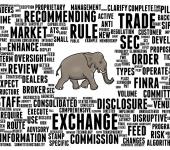Market-Structure in Context: Trading, Risk, Segmentation and Liquidity
A market is a place where people meet to exchange goods and services. Markets can be formal structures such as a fruit or farmers’ market, a mall or an exchange; or informal, where consumers communicate directly (in person, by phone, email or over the internet) with producers and/or vendors. Some markets are regulated (exchanges) and some trade in regulated products (pharmacies). How these markets, both formal and informal, are organized, priced, integrated and regulated impact their pricing efficiency and competitiveness.
Markets can be consumer- or producer-efficient. Consumer-efficient markets aggregate sellers and make it easy to find the best price. Producer-efficient markets funnel consumers toward producers/vendors, making it harder to negotiate price. How interconnected and efficient a market is will determine the economics for the producer, intermediary and investor (see Exhibit 1).
In an efficient market, wholesaler inventory needs to turn over quickly as competition lowers margins and increases risk. In less efficient markets, sparse demand, fewer competitors and regulatory boundaries require higher margins as producers/intermediaries need compensation for manufacturing and holding risk. An apple merchant in a busy market can assume his inventory will turn over quicker, tie up less capital and have less spoilage than in an isolated market where he will be forced to charge more.
Financial markets are similar. Some are efficient and competitive while others support less liquid products and need different economics to exist. Each market needs to find its own equilibrium.
While the execution fabric of the US equity markets is complex and appears to be a one-size-fits-all monolithic structure, it isn’t. To the insider, the nuance of the equity markets creates the flexibility and innovation needed for traders of all stripes not only to express their trading interests but to manage market risk. The current structure provides retail investors with price improvement and institutional investors with a number of mechanisms to effectively trade less liquid large blocks and efficiently trade highly liquid large-cap stocks.
To systemically provide the nuance that floor traders historically provided instinctively, a panoply of diverse – but linked – trading mechanisms and segmentation strategies is required. While these systems, technologies and strategies are complex, the execution fabric created by them enables, on most days, the efficient transfer of risk.
While most investors think the market should be deep and liquid for all stocks, it really isn’t. Most thinly-traded stocks just don’t have significant natural liquidity. The challenge for the institutional investor is to ascertain how long they can wait to find a natural other side. But most investors, and especially those who need instant liquidity, must understand that liquidity is a product with a real price. The question then becomes: How much of a hurry is the trader in and do they want to pay?
On the other side, the firm absorbing risk needs to know either where a willing other side is or can be found, or how to offset that risk through hedging via an index-type product, an option, a future or a synthetic hedge (a more liquid product with a fairly high correlation).
While it would be nice if liquidity were unlimited, unfortunately for most products, it isn’t. The goal of any market is to ensure that the cost, supply and risk of obtaining and managing liquidity is balanced. While convoluted and complex, the US equities market – in most instances – not only fits these criteria but excels in reaching these goals.
This note will discuss risk transfer, market making, segmentation, trading venues and the routing of equity orders to efficiently match buyers and sellers.
- Equities





